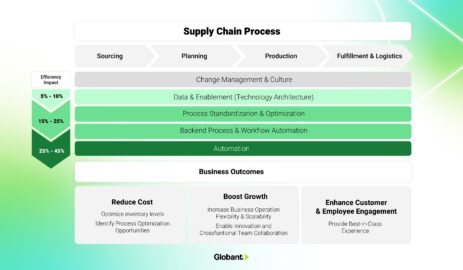What is supply chain management combined with artificial intelligence (AI)? The annual potential value for AI and supply chain management (SCM) is estimated at over $300 billion, most of which is driven by traditional AI and analytics. If we break down this bold figure by component, three main areas explain the potential value:
- Demand forecasting is estimated to represent ~60% of the value potential
- Logistics network and warehouse optimization are estimated to represent ~35% of the value potential
- Sourcing and procurement are estimated to represent ~5% of the value potential
Although the value to capture is certain, roughly half of the companies are investing in AI in some form, but only 10% are investing in AI applications for SCM. What’s even more intriguing is that when looking at how the efforts are distributed across SCM, there seems to be equal focus on demand forecasting and logistics network and warehouse optimization when, as aforementioned, there is more value at stake in demand forecasting.
Hence, why are so many companies lagging in AI and supply chain deployment? Are there any roadblocks we haven’t yet sorted out? What could potentially be done to solve this?
In this article, we address these questions, outline the primary considerations a company needs to take for a successful AI implementation, summarize how to take full advantage of AI and automation in SCM, and detail some compelling applications and use cases that we believe are game-changers for AI and supply chain.
Why are companies failing to implement AI successfully?
While serving our clients, we have validated with our industry experts that 60-80% of all AI projects are falling short of their original goal. Common mistakes include lack of or insufficient alignment among business & AI strategy, processes, data maturity, and infrastructure.
Moreover, companies are confusing AI projects as application development or functionality-driven projects. They often perceive them as data projects or sometimes data products. To achieve the desired outcome, AI projects require a focus on data iteration and data-centric methods once the correct coding and algorithm have been implemented.
Another common misconception is that the Agile methodology, a fast and non-linear approach to implementing a project, works for AI projects – especially projects related to SCM. Although Agile is an excellent methodology in most product development projects, it might fail when dealing with AI because it does not define how to deal with data, the fundamental asset of AI algorithms. The same happens with other methodologies, such as waterfall. A more appropriate approach for AI implementation is the Cognitive Project Management for AI (CPMAI), which blends data-centric approaches with agile methodologies to produce optimal methods for AI projects’ highly data-centric, variable nature.
Successful AI implementation: What can be done to streamline efforts efficiently?
At Globant, and especially for AI and supply chain, we tackle the problem from 3 angles: Change Management & Culture, Data & Enablement, Processes Standardization, and IT Infrastructure
Regarding SCM, the panorama can become more challenging due to the number of systems, uneven data distribution, and complex processes that must ensure collaboration across different teams for smooth operations. Therefore, our vision suggests an end-to-end supply chain approach where the three pillars mentioned before are evaluated at every step, empowering companies to achieve a competitive advantage through AI automation.

Figure 1. Globant’s framework for AI Automation
First, AI implementation is unsuccessful when the culture and change management strategy is not aligned correctly. It is critical to understand the company’s readiness, define a change management roadmap and vision, and identify key stakeholders. This must be followed by plans, artifacts, actions, guidelines, and training material. Simultaneously, there is a need to be aligned between this plan and the evolution of the main project implementation roadmap, allowing alignment between the different business units.
We also need to understand that this journey isn’t just about technology—it’s about people. We can’t forget about the human element of our business model as we automate processes and move toward a more digital supply chain. That means defining business process scope by prioritizing those critical processes/tasks with high impact over the entire supply chain and ensuring clear KPIs and OKRs to define full accountability and measure improvements. It also means reviewing our operating model so that we can scale faster.
Secondly, it is crucial to understand your current data management foundation. This should start with a data accessibility assessment, which will help you understand the requirements, scope, and use cases you must address. Once you’ve identified these needs, it’s time to develop a strategy for using the right data to improve your company’s customer value, operations, and decision-making process. After defining this strategy and identifying gaps in your tech stack, it’s time to develop and maintain the new systems aligned with your new requirements.
As we continue to automate our supply chain and move toward a digital supply network, we must remember the core values that keep us moving forward. First and foremost, it needs to remember that this journey is not just about automating processes but about creating value. We want to ensure our processes are robust and standardized, but they should also be optimized for maximum efficiency and effectiveness. This means we must take a value-driven approach rather than simply focusing on the technology itself.
At Globant, we developed a decision platform for data-driven companies called Navigate using process mining and machine learning technology. The tool is an AI/ML-based learning process that creates and evolves predictions and prescriptions. It enables companies to make intelligent data-driven decisions by anticipating multiple possible future scenarios and simulating their results. We want to ensure that we take advantage of short-term RPA opportunities while laying out a long-term vision for automation (and everything in between).
All the elements described before are the drivers required to build a clear implementation roadmap that shows how the company can progressively reach a higher maturity level that aligns with its business strategy and provide actionable recommendations to successfully achieve an AI automation implementation in Supply Chain, allowing to become a leading innovative organization by tapping into new technologies to be the most cost-efficient, most reliable, faster go-to-Market faster player, along with a more responsible supply chain.
Throughout the years, Globant has been advising clients on implementing AI to realize process improvements and efficiencies in the Supply Chain space. As this Stay Relevant blog post outlines, we’ve identified the main areas in SCM where AI can minimize costs and increase outputs: “Autonomous supply chain via AI: Understanding main areas for improvement and use cases.”
Key takeaways
There is considerable value at stake when implementing AI in SCM, especially in demand forecasting, but capturing the potential value demands a holistic approach to planning and implementing AI.
- Three main areas explain the potential value of AI in SCM:
- Demand forecasting
- Logistics network & warehouse optimization
- Sourcing and procurement
- Companies fall short when implementing AI because:
- Their lack of alignment between business & AI strategies
- Projects are usually siloed
- Incorrect methodologies are not accurately leveraged
- Companies would approach this from three angles:
- Change Management & Culture,
- Processes standardization, and
- IT Infrastructure





